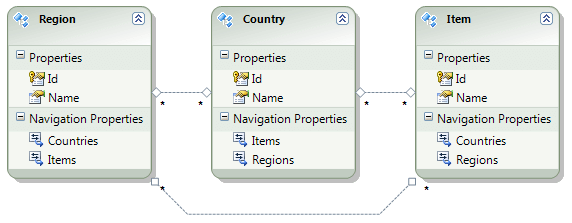With the introduction of LINQ, the difference between writing code for accessing a list of objects in memory and accessing a list of data in an external data source like SQL Server is vanishing.
Combining an “in memory” list with an external list in a single query was not yet possible. With the introduction of .NET Framework 4.0 this has changed.
In this article, I want to filter my SQL data using a list of integers I have stored in memory.
Data model
I have created a small data model as illustration. This will be used for the examples. Follow the link on the image below for a larger version. The model is part of the sample code.

IQueryable.Join
The first option you can use is to use the Queryable.Join method.
var entities = new DemoModelContainer();var countryIds = Enumerable.Range(1, 3);
var query = from i in entities.Items from c in i.Countries join cid in countryIds on c.Id equals cid select i;
var items = query.ToList();When you look at the generated SQL Statement (I love IntelliTrace!) you can see a temporary table is created by using the UNION ALL statement.
SELECT [Extent1].[Id] AS [Id], [Extent1].[Name] AS [Name]FROM [dbo].[Items] AS [Extent1] INNER JOIN [dbo].[CountryItem] AS [Extent2] ON [Extent1].[Id] = [Extent2].[Items_Id] INNER JOIN ( SELECT [UnionAll1].[C1] AS [C1] FROM ( SELECT 1 AS [C1] FROM (SELECT 1 AS X) AS [SingleRowTable1] UNION ALL SELECT 2 AS [C1] FROM (SELECT 1 AS X) AS [SingleRowTable2] ) AS [UnionAll1] UNION ALL SELECT 3 AS [C1] FROM (SELECT 1 AS X) AS [SingleRowTable3] ) AS [UnionAll2] ON [Extent2].[Countries_Id] = [UnionAll2].[C1]What happens is that 2 values are combined in a set, this set is extended with the next value, this set is extended with another value, and so on, and so on, until all values are present.
This works nicely, but as you can imagine, the SQL query will grow rapidly when the IEnumerable list gets larger.
When you change the following:
var countryIds = Enumerable.Range(1, 3);var countryIds = Enumerable.Range(1, 50);you will run into a SqlException:
“Some part of your SQL statement is nested too deeply. Rewrite the query or break it up into smaller queries.”
SQL Server has a hard-coded limit of nesting queries; it doesn’t matter which version or edition of SQL Server you use.
IEnumerable Contains
Joining tables is one way of filtering data, an alternative is to use the WHERE statement.
This can be done by using the Queryable.Where method.
var entities = new DemoModelContainer();var countryIds = Enumerable.Range(1, 3);
var query = from i in entities.Items from c in i.Countries where countryIds.Contains(c.Id) select i;
var items = query.ToList();When you look at the generated SQL Statement (Still loving IntelliTrace!) you can see now the IN statement is used.
SELECT [Extent1].[Id] AS [Id], [Extent1].[Name] AS [Name]FROM [dbo].[Items] AS [Extent1] INNER JOIN [dbo].[CountryItem] AS [Extent2] ON [Extent1].[Id] = [Extent2].[Items_Id]WHERE [Extent2].[Countries_Id] IN (1,2,3)This SQL Query is much smaller and filtering against a larger set will not give you the exception.
This is how the WHERE statement looks when filtering on 50 values:
WHERE [Extent2].[Countries_Id] IN (1,2,3,4,5,6,7,8,9,10,11,12,13,14,15, 16,17,18,19,20,21,22,23,24,25,26,27, 28,29,30,31,32,33,34,35,36,37,38,39, 40,41,42,43,44,45,46,47,48,49,50)Conclusion
You can use both methods to filter SQL data with a list in memory.
But when choosing for the join method you should be sure your query will not reach the maximum level of nesting.
I prefer to use Contains method.
Although I used a many-to-many relation in this example, the same applies for a one-to-many scenario.
Sample code
I have added a small Visual Studio 2010 project so you can see the SQL statements for yourself.
You will need SQL Server Express 2008 R2 installed on your machine to run the code.